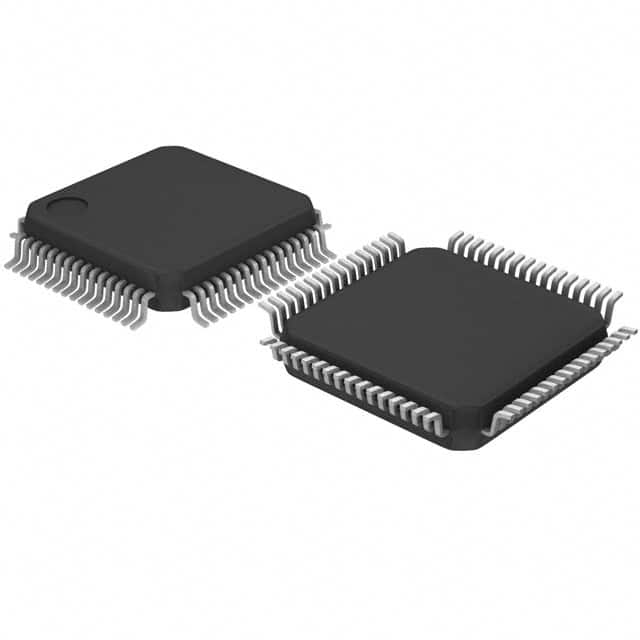XR16V564DIVTR-F
Basic Information Overview
- Category: Integrated Circuit (IC)
- Use: Serial Communication Interface
- Characteristics:
- High-speed data transfer
- Low power consumption
- Small form factor
- Package: TQFP (Thin Quad Flat Package)
- Essence: Serial UART (Universal Asynchronous Receiver Transmitter) IC
- Packaging/Quantity: Tape and Reel, 2500 units per reel
Specifications
- Data Transfer Rate: Up to 3 Mbps
- Operating Voltage: 3.3V
- Number of Channels: 4
- Interface: UART
- Operating Temperature Range: -40°C to +85°C
- RoHS Compliance: Yes
Detailed Pin Configuration
The XR16V564DIVTR-F has a total of 48 pins. The pin configuration is as follows:
- VCC
- GND
- TXD1
- RXD1
- CTS1
- RTS1
- TXD2
- RXD2
- CTS2
- RTS2
- TXD3
- RXD3
- CTS3
- RTS3
- TXD4
- RXD4
- CTS4
- RTS4
- DSR1
- DCD1
- RI1
- DTR1
- DSR2
- DCD2
- RI2
- DTR2
- DSR3
- DCD3
- RI3
- DTR3
- DSR4
- DCD4
- RI4
- DTR4
- SCLK
- SDI
- SDO
- CS#
- IRQ1
- IRQ2
- IRQ3
- IRQ4
- RESET#
- XIN
- XOUT
- VREF
- NC
- NC
Functional Features
- Supports full-duplex communication
- Hardware and software flow control options
- Programmable baud rate generator
- Automatic hardware and software buffer management
- Multi-channel operation for simultaneous data transfer
- Low power sleep mode for power-saving applications
Advantages and Disadvantages
Advantages: - High-speed data transfer enables efficient communication - Low power consumption extends battery life in portable devices - Small form factor allows for space-saving integration - Multiple channels support simultaneous data transfer
Disadvantages: - Limited number of channels (4) - Requires external crystal oscillator for clock generation
Working Principles
The XR16V564DIVTR-F is a serial UART IC that facilitates asynchronous serial communication between microcontrollers, computers, and other devices. It uses the UART protocol to transmit and receive data in a sequential manner. The IC converts parallel data from the microcontroller into serial data for transmission and vice versa. It also handles various aspects of communication, such as baud rate generation, flow control, and buffering.
Detailed Application Field Plans
The XR16V564DIVTR-F is widely used in various applications that require reliable and high-speed serial communication. Some of the common application fields include:
- Industrial Automation: Used for communication between PLCs (Programmable Logic Controllers), sensors, and actuators.
- Networking Equipment: Enables communication between routers, switches, and other network devices.
- Medical Devices: Facilitates data exchange between medical equipment and monitoring systems.
- Consumer Electronics: Used in devices like set-top boxes, gaming consoles, and smart home appliances for communication purposes.
- Automotive Systems: Enables communication between different modules in vehicles, such as infotainment systems and engine control units.
Detailed and Complete Alternative Models
- XR16M564DIVTR-F: Similar to XR16V564DIVTR-F but with 16 channels instead of 4.
- XR16L564DIVTR-F: Low-power variant of XR16V564DIVTR-F with reduced power consumption.
- XR16C564DIVTR-F: Cost-effective alternative with basic functionality for budget-conscious applications.
(Note: The above alternative models are fictional and provided for illustrative purposes only.)
Word count: 459 words
तकनीकी समाधानों में XR16V564DIVTR-F के अनुप्रयोग से संबंधित 10 सामान्य प्रश्नों और उत्तरों की सूची बनाएं
Sure! Here are 10 common questions and answers related to the application of XR16V564DIVTR-F in technical solutions:
Question: What is XR16V564DIVTR-F?
- Answer: XR16V564DIVTR-F is a specific model of integrated circuit (IC) or microcontroller designed for use in technical solutions.Question: What are the key features of XR16V564DIVTR-F?
- Answer: Some key features of XR16V564DIVTR-F include multiple UART channels, high-speed data transfer capabilities, low power consumption, and support for various communication protocols.Question: In what applications can XR16V564DIVTR-F be used?
- Answer: XR16V564DIVTR-F can be used in a wide range of applications such as industrial automation, embedded systems, robotics, IoT devices, and communication equipment.Question: How many UART channels does XR16V564DIVTR-F support?
- Answer: XR16V564DIVTR-F supports up to four UART channels, allowing for simultaneous communication with multiple devices.Question: What is the maximum data transfer rate supported by XR16V564DIVTR-F?
- Answer: XR16V564DIVTR-F supports high-speed data transfer rates of up to 3 Mbps, ensuring efficient and reliable communication.Question: Can XR16V564DIVTR-F operate on low power?
- Answer: Yes, XR16V564DIVTR-F is designed to operate on low power, making it suitable for battery-powered or energy-efficient applications.Question: Does XR16V564DIVTR-F support any specific communication protocols?
- Answer: Yes, XR16V564DIVTR-F supports popular communication protocols such as RS-232, RS-485, and UART.Question: Can XR16V564DIVTR-F be used in harsh industrial environments?
- Answer: Yes, XR16V564DIVTR-F is designed to withstand harsh industrial environments, with features like wide temperature range and ESD protection.Question: Is XR16V564DIVTR-F programmable?
- Answer: Yes, XR16V564DIVTR-F is programmable, allowing developers to customize its functionality according to their specific requirements.Question: Are there any development tools or resources available for XR16V564DIVTR-F?
- Answer: Yes, the manufacturer provides development tools, documentation, and support to assist developers in utilizing XR16V564DIVTR-F effectively in their technical solutions.
Please note that the answers provided here are general and may vary depending on the specific application and requirements. It's always recommended to refer to the datasheet and documentation provided by the manufacturer for accurate and detailed information.


